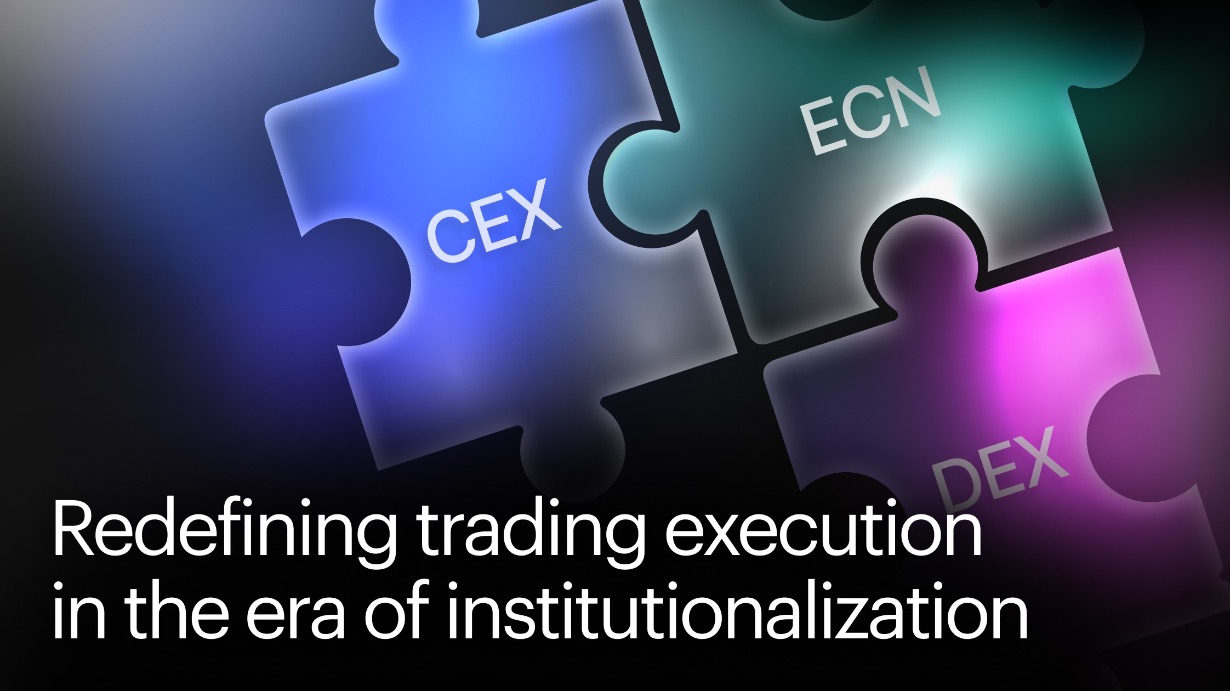
Institutional participants have become significant players in crypto markets, accounting for a large share of trading activity. In North America, roughly 70% of crypto transaction volume (by value) now comes from transfers over $1 million, indicating the growing influence of hedge funds, trading firms, banks, and other institutions.
As large market participants seek the most efficient and secure avenues for trading digital assets, they turn to three primary execution venues: Centralized Exchanges (CEXs), Decentralized Exchanges (DEXs), and Electronic Communication Networks (ECNs). Each of these trading infrastructures offers its unique marker design, shaped by considerations such as liquidity depth, execution speed, market access, custody solutions, and the regulatory landscape.
Despite the fact that DEXs provide an alternative trading infrastructure where transactions occur entirely on-chain without the need for intermediaries, challenges persist, particularly for institutions. Compliance and anti-money laundering (AML) concerns remain significant hurdles. Additionally, DEX liquidity is fragmented, and on-chain order matching introduces excessive delays compared to the near-instantaneous execution speeds found in centralized exchanges (CEXs) and electronic communication networks (ECNs). These factors make DEXs less attractive to institutional participants.
This article explores how institutions interact with CEXs and off-exchange ECN-like platforms. It also looks at how changes in market structure and regulations affect their decisions.
Centralized Exchanges (CEXs)
Centralized exchanges are trading platforms operated by a central authority that facilitates crypto transactions through off-chain order matching via a Central Limit Order Book (CLOB).
CEXs serve as structured gateways to blockchain-based assets, providing institutional participants with access to liquidity while also managing fund deposits, withdrawals, and final settlements. In the crypto industry CEXs also function like traditional brokers by providing customers direct access to their matching engine and managing risks. These venues attract substantial liquidity, making them the primary choice for institutional participants seeking fast execution through familiar trading mechanisms.
However, a growing number of institutional participants are moving away from exchange-managed custody solutions, preferring third-party crypto custodians to handle settlements and enhance asset security. Additionally, some participants have raised concerns regarding the current market-making practices on certain exchanges. This shift reflects lessons learned from high-profile exchange collapses and liquidity crises, underscoring the need for segregated custody models to minimize counterparty risk, as well as improved oversight of trading practices.
OTC Markets: Electronic Communication Networks (ECNs) and Smart Order Routers (SORs)
Electronic Communication Networks (ECNs)
ECNs, widely used in traditional financial markets, provide direct connectivity between buyers and sellers without relying on a central authority. In crypto, ECNs act as efficient marketplaces within Over-the-Counter (OTC) markets that link liquidity takers with liquidity providers.
While both CEXs and ECNs utilize off-chain matching engines, ECNs differentiate themselves by employing diverse execution models, such as:
-
Central Limit Order Books (CLOB): Traditional price-time priority matching mechanisms.
-
Request for Quote (RFQ): Enabling traders to obtain real-time quotes from liquidity providers.
-
Request for Stream (RFS): Continuous pricing streams from market makers.
-
Hybrid models: Combining multiple execution methods for flexibility and efficiency.
Additionally, ECNs prioritize transparent trade execution and counterparty discovery, often utilizing blockchain networks to store transaction data and settlement records, enhancing auditability and security.
Smart Order Routers (SORs)
Smart Order Routers (SORs) are algorithmic tools designed to optimize trade execution by simultaneously scanning multiple CEXs, ECNs, and other OTC trading venues for the best available liquidity and pricing. By fragmenting large institutional orders across multiple pools, SORs help minimize market impact and achieve superior execution quality.
Unlike CEXs and some ECNs, SORs do not serve as trading venues themselves; instead, they function as liquidity aggregation tools. While they enhance execution efficiency, it’s important to note that liquidity providers receiving client orders through SORs have the option to reject trades (a practice known as “last look”), which can lead to a deterioration in execution quality, especially during periods of high market volatility.
Crypto Trading and Settlement Infrastructure
The architecture of CEXs, and OTC platforms like ECNs follows a layered structure designed to support institutional trading at scale:
1. Settlement Layer
-
The base layer (L1 or L2 blockchain) responsible for recording transaction settlements and ownership data.
-
Includes Bitcoin, Ethereum, Solana, Tron and Layer-2 solutions like Arbitrum or Optimism.
2. Asset Layer
-
Contains various native tokens and wrapped assets issued atop the settlement layer.
-
Stablecoins, wrapped Bitcoin (WBTC), memecoins, and tokenized assets fall under this category.
3. Trading Protocol Management
-
CEXs and ECNs require a distinct off-chain management entity to facilitate trade matching and access to blockchain networks.
-
DEXs replace centralized entities with smart contract-based trading protocols, such as Uniswap’s AMM mechanism or order book-based DEXs like dYdX.
4. Off-Chain Interaction and User Interface
-
The final layer manages off-chain user interactions, including API connectivity, trading dashboards, and algorithmic execution systems.
-
This layer is essential for integrating institutional trading desks, quant firms, and market makers into the broader crypto ecosystem.
.png)
Convergence with Traditional Market Practices
As institutional participation in crypto markets grows, there is a noticeable convergence between digital asset trading and traditional financial market structures. Established trading mechanisms from equities and forex markets are increasingly being adapted for crypto, resulting in a more mature and sophisticated trading environment.
Key areas of convergence include:
-
Prime Brokerage Services – Institutions now rely on crypto prime brokers to facilitate multi-exchange access, aggregated liquidity, and post-trade settlement, similar to equities and FX markets.
-
Algorithmic Trading & Execution – High-frequency trading firms and quant funds are applying advanced execution algorithms, such as TWAP (Time-Weighted Average Price) and VWAP (Volume-Weighted Average Price), to optimize order execution across fragmented crypto venues.
-
Clearing and Settlement Innovations – The introduction of clearing solutions and net settlement systems, akin to traditional market clearinghouses, is reducing counterparty risk and increasing trading efficiency.
-
Institutional Custody and Risk Management – Secure digital asset custody solutions are evolving to meet institutional compliance and regulatory requirements, ensuring better risk management and asset protection.
This ongoing convergence is making crypto trading more accessible and familiar to institutional investors, driving further adoption and integration with global financial markets.
Conclusion
Institutional engagement in crypto trading is no longer a tentative toe in the water but a growing wave that is reshaping the market. Centralized Exchanges remain the go-to venues for most institutions due to their liquidity and familiarity, but there is a clear push for higher standards of security, transparency, and regulation in these venues post-FTX. Decentralized Exchanges are still a niche in direct institutional usage, but they have proven their worth in providing alternative liquidity and self-custodial options, especially for crypto-native funds – and they stand to gain more traction as regulatory clarity and technical solutions make them safer and easier to use. Meanwhile, ECN-like platforms and institutional-only exchanges are emerging as compelling solutions to marry the benefits of CEX and DEX: offering fast, low market impact execution without custodial risk, tailored for the needs of professional participants.
Liquidity considerations are paramount: institutions will gravitate to where they can execute large orders efficiently. Right now that is still primarily on major CEXs (and CME for Bitcoin futures), but DEX liquidity for top assets and new ECN liquidity pools are steadily growing. Execution efficiency is being addressed on all fronts – from CEXs upgrading tech and providing algos, to DEXs using Layer-2 scaling, to ECNs bringing millisecond matching. Market access has broadened as well: an institution in 2021 might have been limited to a couple of counterparties; in 2025, that same institution can access dozens of venues through an integrated prime broker or trading system, allocating orders across CEX, DEX, and ECN to optimize results.
This confluence of developments suggests that institutional traders will increasingly have the confidence and capability to choose the optimal execution venue for any given strategy – whether that’s tapping a centralized exchange for deep immediate liquidity, a decentralized exchange for specific assets or self-custody advantages, or an ECN for minimal slippage and counterparty risk. In essence, the crypto market is becoming a microcosm of global finance with a variety of venues to serve different needs, and institutions are leveraging all of the above as the ecosystem matures.



.png)

(1).png)




















